
This image of a buffalo hunt shows the chaos and violence of it, which would provide the Native American men hunting, as well as their village, with well-needed sustenance. Several men are on horseback, drawing back arrows, hoping to injure one of the large and intimidating creatures. Others are brandishing spears which they plan to strike the animals with. In the bottom left-hand corner, a Native American man is grappling onto a spear which has apparently struck a buffalo. It seems he is trying to manipulate his weapon to coax the animal into collapsing to the ground, considering he already has the animal kneeling down. In the center of the portrait, a man is on horseback as the horse is lifted by the force of a charging buffalo, rendering the horse and man immobilized; however, the man is wielding his spear in order to strike the wild beast. Below this scene, there is a vulnerable man lying on the rough exterior of the earth and holding his back. This man appears to be injured or seriously wounded, an often occurrence during these hunts. This scene is graphic and violent, but depicts the hunt in a respectable manner. The detail of this drawing is stunning; the taut muscles of the horses are flexing and bulging through their smooth coats, showing the immense strain being put upon them. Also seen is the rough and coarse hair of the buffalo, massive and powerful creatures with stubby legs and bulky bodies. The men in the scene are also shown with very muscular bodies, which are needed for strenuous activities such as this portrait depicts. The backdrop of the scene is a mountain range which connects to the hills of the countryside, and countless trees. There are also two columns of smoke drifting towards the sky, giving the observer the conclusion that the smoke is emerging from the men's village abodes.
The entirety of this portrait is in black and white, showing that it was, in fact, drawn as well as the fact that there is immense detail to which no paint brush could depict. The background, as noted before, was an old and majestic mountain range with snow-capped mountain tops which eventually fade into the country side. The smoke seems to make its way up to the blue sky from the edge of the mountain and fills the air with its opaque appearance and smoky aroma. This background helps keep balance in the portrait with the foreground, the scene of the hunt. The chiaroscuro, the sharp, dramatic distinction between light and dark, is prevalent in the creases and shadows of the muscles of man and animal through the Native American men and their horses which is highlighting their strength and power. The contrast of the violence of the hunt and the serenity of nature in the background is astonishing, and it is not surprising that the focal point is not the mountain ranges that are present in the background. The focal point, which also happens to be the emphasis of the portrait, is the man riding horseback brandishing a spear, seemingly trying to attack the buffalo that is charging towards his horse which is being lifted into the air by the force of the wild animal. The varying amounts of shades and value, the amount of light and or dark, as well as the recurrence of strong and weak elements, help create rhythm and movement throughout the piece; the observer is able to imagine this scene taking place as the bulls are charging and defending themselves while the horses are parading around the buffalo, avoiding direct confrontation, while the men are wielding their weapons to attack the wild buffalo. All of these elements create unity and harmony throughout the image, as it incorporates all pieces into the meaning and significance of the portrait in its entirety.
Looking at this image, there are clearly several possible narratives that the observer could create in his or her mind while focusing on the scene. The most obvious narrative is an everyday hunt for food, which is necessary to support life. These men could have left their village in the morning, with the well-wishes of their beloved families and neighbors, hoping to obtain enough meat until the next hunt. Anxiety and pressure could be building inside of each of them, hoping that the universal forces of Mother Nature supply them with the capability of attacking the wild animals. Another possible narrative includes a young man who is on is first hunt, nervous and scared because of the tenacity of the buffalos who refuse to be taken as nourishment and the brute strength needed to succeed in killing one. Another narrative, though not as obvious, is one which depicts the struggle of the man who is lying defenselessly on the earth, mortally wounded and petrified of his looming and impending death. The animation and vibrancy of the portrait makes envisioning these narratives an effortless task.
The entirety of this portrait is in black and white, showing that it was, in fact, drawn as well as the fact that there is immense detail to which no paint brush could depict. The background, as noted before, was an old and majestic mountain range with snow-capped mountain tops which eventually fade into the country side. The smoke seems to make its way up to the blue sky from the edge of the mountain and fills the air with its opaque appearance and smoky aroma. This background helps keep balance in the portrait with the foreground, the scene of the hunt. The chiaroscuro, the sharp, dramatic distinction between light and dark, is prevalent in the creases and shadows of the muscles of man and animal through the Native American men and their horses which is highlighting their strength and power. The contrast of the violence of the hunt and the serenity of nature in the background is astonishing, and it is not surprising that the focal point is not the mountain ranges that are present in the background. The focal point, which also happens to be the emphasis of the portrait, is the man riding horseback brandishing a spear, seemingly trying to attack the buffalo that is charging towards his horse which is being lifted into the air by the force of the wild animal. The varying amounts of shades and value, the amount of light and or dark, as well as the recurrence of strong and weak elements, help create rhythm and movement throughout the piece; the observer is able to imagine this scene taking place as the bulls are charging and defending themselves while the horses are parading around the buffalo, avoiding direct confrontation, while the men are wielding their weapons to attack the wild buffalo. All of these elements create unity and harmony throughout the image, as it incorporates all pieces into the meaning and significance of the portrait in its entirety.
Looking at this image, there are clearly several possible narratives that the observer could create in his or her mind while focusing on the scene. The most obvious narrative is an everyday hunt for food, which is necessary to support life. These men could have left their village in the morning, with the well-wishes of their beloved families and neighbors, hoping to obtain enough meat until the next hunt. Anxiety and pressure could be building inside of each of them, hoping that the universal forces of Mother Nature supply them with the capability of attacking the wild animals. Another possible narrative includes a young man who is on is first hunt, nervous and scared because of the tenacity of the buffalos who refuse to be taken as nourishment and the brute strength needed to succeed in killing one. Another narrative, though not as obvious, is one which depicts the struggle of the man who is lying defenselessly on the earth, mortally wounded and petrified of his looming and impending death. The animation and vibrancy of the portrait makes envisioning these narratives an effortless task.
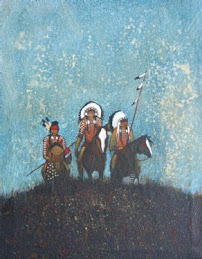
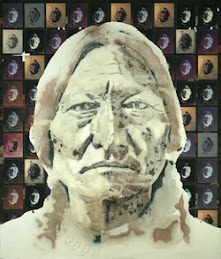
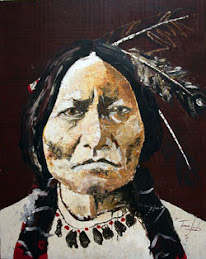


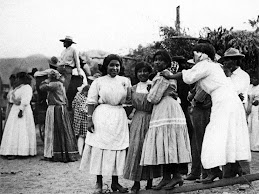







,+Peggy+O%27Neal.jpg)
,+Peggy+O%27Neal.jpg)
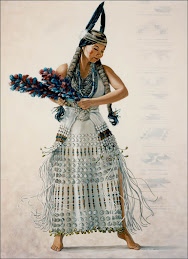,+Peggy+O%27Neal.jpg)
,+Peggy+O%27Neal.jpg)
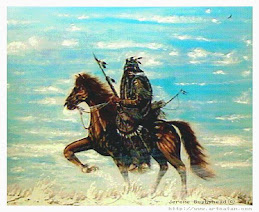


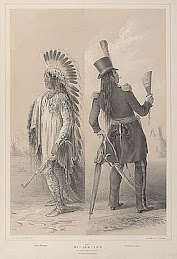


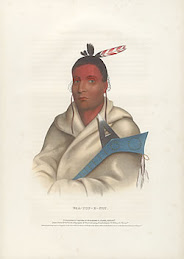
No comments:
Post a Comment